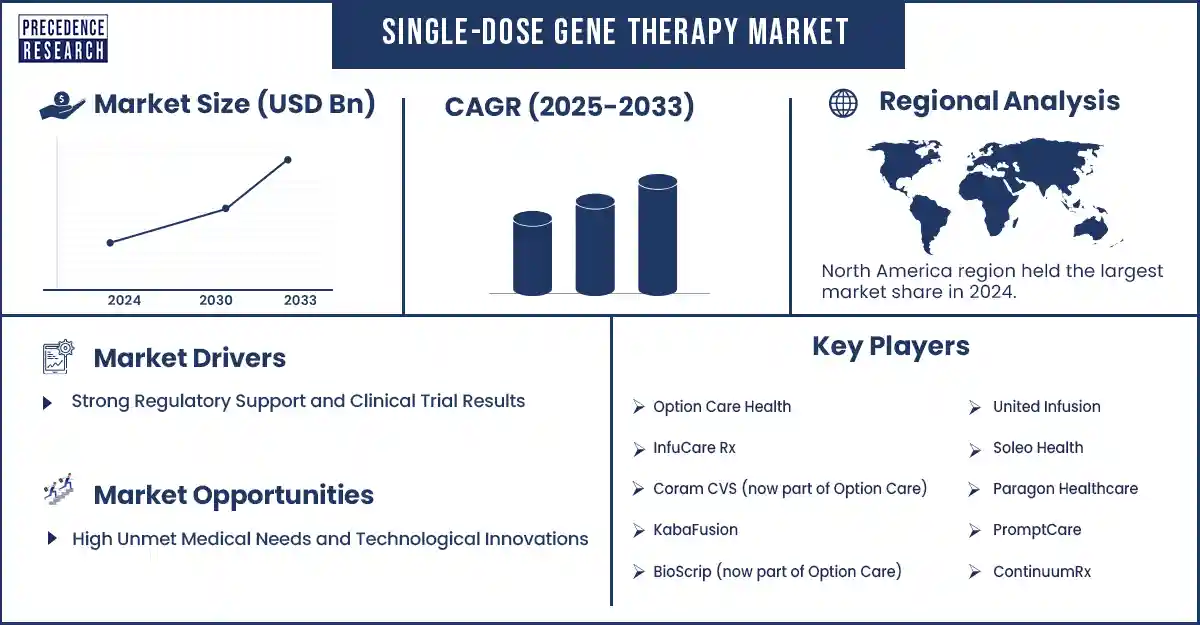Single-Dose Gene Therapy Market Revenue and Forecast by 2033
Single-Dose Gene Therapy Market Revenue and Trends 2025 to 2033
The Single-Dose Gene Therapy Market is projected to grow through 2033, driven by advancements in gene editing, rising demand for one-time treatments, and increasing prevalence of genetic and rare diseases. The growth of the market is attributed to the rising demand for one-time curative treatments for rare and chronic diseases. Increasing regulatory approvals and expanded clinical trials are expected to drive market growth.

Market Overview
The single-dose gene therapy market is poised for robust growth, propelled by several factors reshaping healthcare's future. Emerging genetic disorders and rare diseases are driving the need for more targeted, durable solutions where a single-dose therapy can offer a potential one-time cure. This represents a significant advancement over existing treatments, whether pharmacological or surgical, leading to improved health outcomes and substantially lowered lifetime healthcare costs for patients. Technological advancements in vector development, particularly with adeno-associated viruses (AAVs), are enhancing the safety and efficiency of gene delivery. Moreover, increased funding for research projects from both public and private organizations is fostering market growth.
Segment Insights
- By therapy type, the in vivo gene therapy segment continues to dominate the market, thanks to its direct delivery, higher efficiency, and expanding range of applications for curing rare genetic disorders.
- By vector type, the AAV-based vectors segment held the largest share of the market in 2024 due to their established safety, effective gene delivery, and significant evidence of clinical success in treating rare diseases.
- By disease area, the neuromuscular disorders segment dominated the market, accounting for a significant share in 2024. This is mainly due to the increased incidence of disorders like spinal muscular atrophy (SMA), prompting the need for effective therapeutics, including single-dose gene therapy.
- By patient type, the pediatric segment dominated the market in 2024 as this patient group often requires one-time curative treatments to improve the quality of life. The rising incidence of genetic disorders among children creates the urgency for effective, long-lasting, curative therapies.
- By route of administration, the intravenous (IV) segment led the market, holding the largest share in 2024 due to the ease of administration and high control over dosage. The rising demand for targeted drug delivery contributes to segmental growth.
- By end-user, the hospitals and specialty clinics segment held the largest share of the single-dose gene therapy market in 2024, primarily due to the advanced infrastructure in place to support the administration of gene therapies. These settings are outfitted with advanced drug delivery systems, attracting more patients to receive care from them.
Regional Insights
North America dominated the single-dose gene therapy market in 2024. This is mainly due to a well-established biotech industry, increased R&D investments, and favorable regulatory policies. With the increasing prevalence of genetic disorders, there is a high demand for personalized gene therapies. Furthermore, rising partnerships between biotechnology and pharmaceutical companies and academic institutes to accelerate R&D and novel therapies support regional market growth.
Asia Pacific is emerging as the fastest-growing region. There is a rising burden of rare genetic disorders, prompting the need for effective therapeutics like single-dose gene therapy. The rising number of clinical trials in genetic disorders and funding from public and private sectors in R&D contribute to market expansion.
Single-Dose Gene Therapy Market Coverage
| Report Attribute | Key Statistics |
| Quantitative Units | Revenue in USD billion/trillion, Volume in units |
| Largest Market | North Ameirca |
| Base Year | 2024 |
| Regions Covered | North America, Europe, Asia-Pacific, Latin America, and Middle East & Africa |
Recent Development
- In May 2025, Sarepta Therapeutics, Inc. announced that the Japanese Ministry of Health, Labour, and Welfare (MHLW) approved ELEVIDYS (delandistrogene moxeparvovec), a gene therapy to treat Duchenne muscular dystrophy (DMD). ELEVIDYS is approved for individuals ages 3- to less than 8-years-old, who do not have any deletions in exon 8 and/or exon 9 in the DMD gene, and who are negative for anti-AAVrh74 antibodies.
(Source: https://investorrelations.sarepta.com)
Single-Dose Gene Therapy Market Key Players
- Option Care Health
- InfuCare Rx
- Coram CVS (now part of Option Care)
- KabaFusion
- BioScrip (now part of Option Care)
- Amerita (a PharMerica company)
- United Infusion
- Soleo Health
- Paragon Healthcare
- PromptCare
- ContinuumRx
- CareCentrix
- Chartwell Pennsylvania
- Intramed Plus
- AlayaCare
- ClearSky Health
- Healix Infusion Therapy
- Nufactor (a FFF Enterprises company)
- PharMerica Infusion Services
- Infusion Associates
Get this report to explore global market size, share, CAGR, and trends, featuring detailed segmental analysis and an insightful competitive landscape overview @ https://www.precedenceresearch.com/sample/6362
You can place an order or ask any questions, please feel free to contact at sales@precedenceresearch.com |+1 804 441 9344